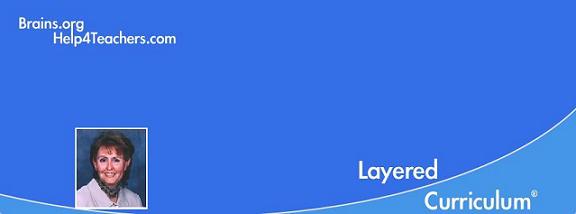__________Layered Curriculum®. . . because every child deserves a special education™_
 |
|
![]() _
_ ![]()
Layered
Curriculum TEXT & WORKBOOK
Set
for only
$43.95
(free shipping in
US)
Tweet
Five Best Practices for Any High SchoolBy Dr. Kathie F. Nunley
(c)2018Years of research and visits to thousands of schools have shown there are some very simple things that can be done in any high school, large or small, urban or suburban, public or independent - that can improve student and teacher performance.
1. Principals teach at least one section of one course for one term every year. Principal is the shortened term for "principal teacher"....an idea that seems lost on most schools today. Being a school principal is a huge responsibility and most of the day is easily consumed with large scale legal, budgetary and administrative duties. But making time to return to a classroom on a regular basis yields huge results. It transforms the way your staff views your policy decisions, it transforms the way you as principal, view the school and students, and it transforms the way the student population views the principal.
2. Students have a "time out" area they can self-select to use at any time. Time-out areas are not punitive, instead they are pro-active melt-down prevention areas. Students who feel themselves losing control, over anxious, or just needing a few moments of personal space and peace are free to excuse themselves to the safe zone. Students are free to stay in the time-out zone as long as they feel they need, but with the understanding that they should be returning to the classroom as soon as they are able. Time-out spots can be a quiet corner in the school library, an area in the main office, or a private section in the nurses office. The area should be supervised by an adult, but the student should be free from intrusions by others.
3. Reading material should be self-selected. Given the robust research on the power autonomy has on motivation, students should be able to choose their textbooks, English novels and outside reading material from a list. Base the constructed list on the learning objectives, and then allow students to choose what they will read or use for their course text.
4. School-wide adoption of healthy habits. Nutrition and exercise are absolutely critical components to learning and brain health. Schools need to integrate nutrition education and physical education into all facets of the school day. Both staff and students should be participating. Suggestions are: (1) snack time, similar to what's found in elementary school, with healthy snacks provided or encouraged to be brought from home, including teachers. (2) price discounts for healthy lunch choices. (3) exercise time allocated at the beginning of alternate class periods, where the students, and staff, walk or jog around the outside of the building or through the halls. (4) before or after school yoga or running clubs including staff and students.
5. Interdisciplinary courses. Design elective courses (or modify current required courses) which specifically meld two or more disciplines. Projects and assignments are completed for credit in two classes. Instruction is alternated between teachers and teacher classroom. Students can move freely between the classrooms during class time to utilize resources and teachers in both rooms.
About the Author:Dr Kathie Nunley is an educational psychologist, researcher and author of several books on parenting and teaching, including A Student's Brain (Brains.org) and the best selling, "Differentiating the High School Classroom" (Corwin Press). She is the developer of the Layered Curriculum� method of instruction and has worked with parents and educators around the world to better structure schools to make brain-friendly environments. In addition, her work has been used by the Boeing Corporation, Family Circle Magazine, the Washington Post, and ABC television.
Email her: Kathie (at) brains.orgCopyright © 1998 - current year by Kathie F. Nunley.
All Rights Reserved.
Layered
Curriculum is a registered trademark developed by
Dr. Kathie F. Nunley.